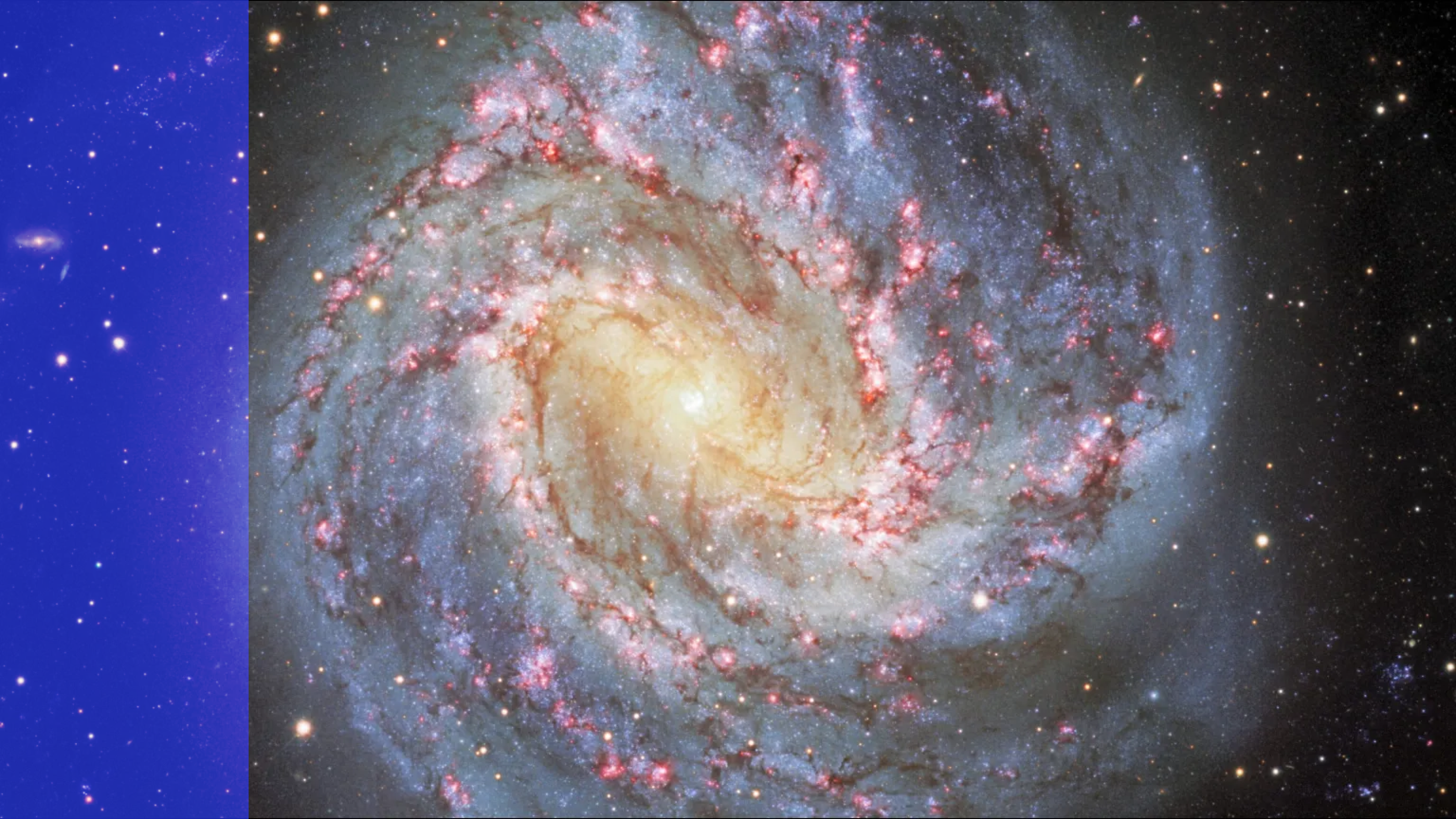The Dark Side Of The Universe
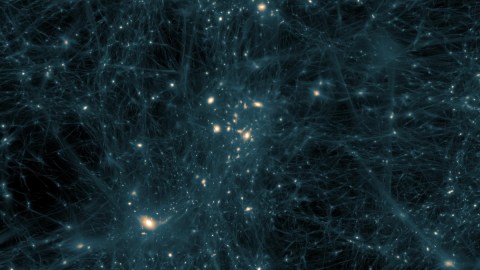
A live-blog event of a fabulous public lecture given by Katie Freese on the unseen components in our Universe.
“If you take everything we know… it only adds up to 5% of the Universe.”
–Katie Freese
When we first realized, in the first half of the 20th century, that our Universe was filled with billions of galaxies extending far beyond our own Milky Way, it was a huge leap in our knowledge and understanding. Each one of those galaxies contained billions of stars of their own, and the vast majority were expanding away from both us and one another, giving us a picture of the expanding Universe. Even with the greatest technology at our disposal today, we can look as far as we want out into the cosmos, and find galaxies into the deepest depths of space, up to some 30+ billion light years away.
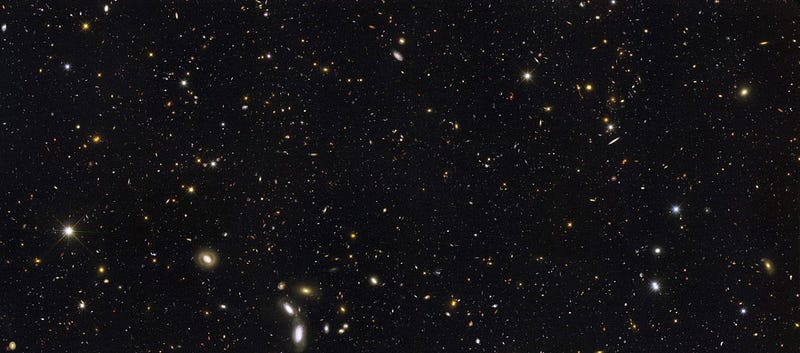
But perhaps shockingly, even looking out this deep into the abyss and finding stars, gas, and all other sorts of luminous and non-luminous matter made up of the same basic things we are — protons, neutrons and electrons — this type of matter cannot and does not make up the vast majority of the Universe. In fact, even if we take a look at all of the known particles in the Standard Model, including all the bosons, all the neutrinos, and the full suite of all the particles known to exist in this Universe, we can only account for about 5% of the total amount of energy present in all of spacetime.
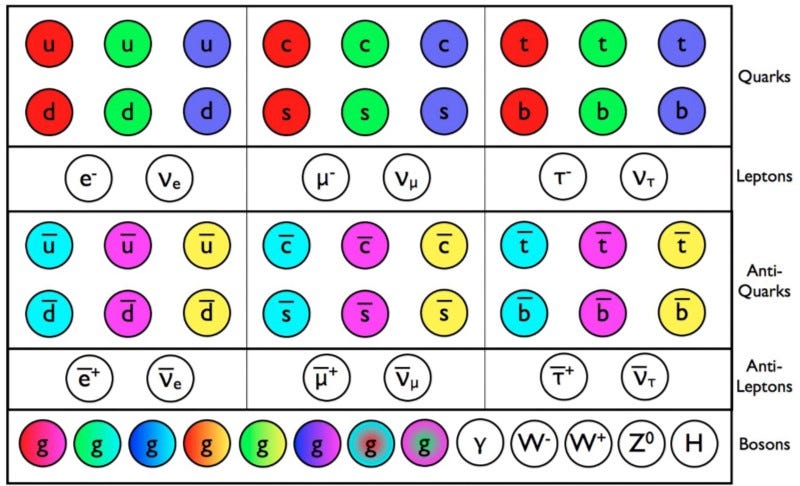
The remaining 95% belongs to what we call the dark sector: dark matter, which gravitates together into clumps like normal matter but doesn’t interact through any of the known quantum mechanical forces, at about 27% total, and dark energy, which causes the Universe’s expansion to accelerate and comprises, today, about 68% of the energy density of the Universe. There’s an amazing story to both dark matter and dark energy, but this “dark side of the Universe” is currently the greatest cosmic mystery of the 21st century. And beginning at 7 PM Eastern (4 PM Pacific) today, March 2nd, you’ll get to watch astrophysicist Katie Freese give a live talk on it, courtesy of Perimeter Institute’s public lecture series.
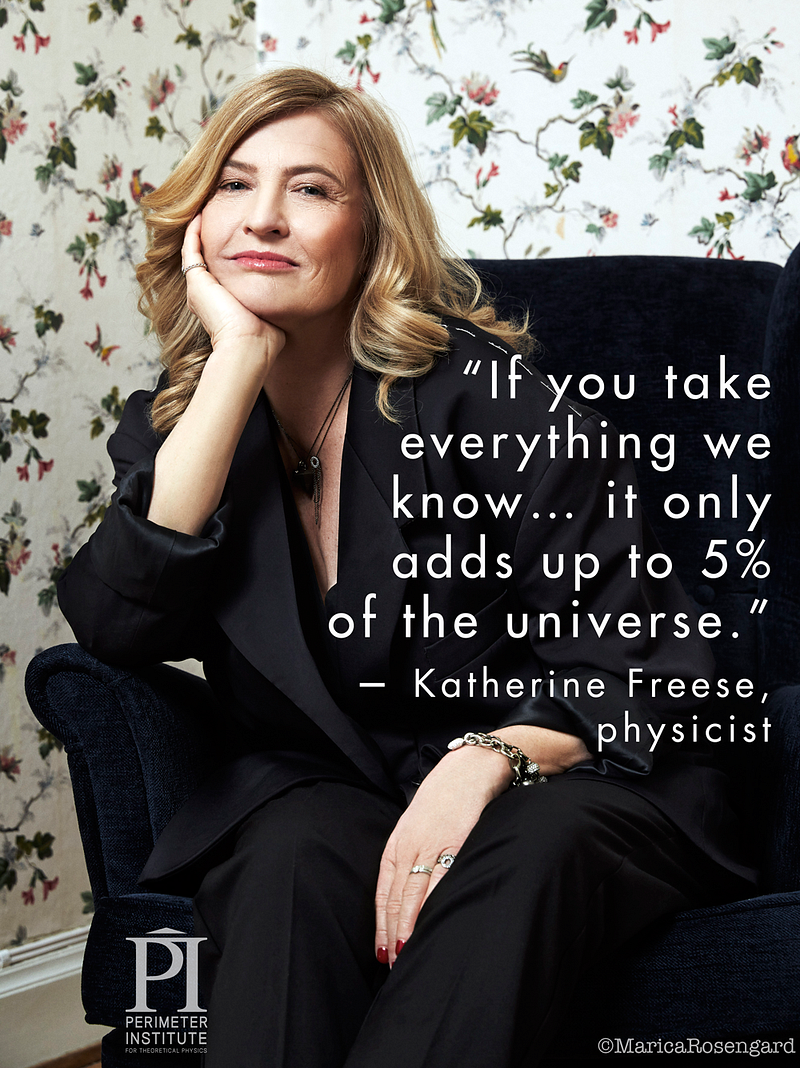
Katie’s research bridges the observational with the theoretical, and strives to test various models of how and why the Universe is expanding and behaving the way it does. Dark matter and dark energy were always regarded as possibilities, but weren’t particularly expected. Yet when you study the Universe, it’s your #1 job to listen to what it tells you about itself, whether you expected it to behave in that fashion or not. Katie gives fantastic talks, and I hope you’ll join me for hers, while I live-blog along with extra commentary and information.
https://www.youtube.com/watch?v=Dl95VgDzcqs
The best way to watch is to open this video, above, and then in a separate tab/window, follow along here by refreshing the page. Updates are every 5 minutes, tops, so tune in and enjoy!
Update, 3:48 PM Science!!!

That’s right, Americans, Canada values science so much that they have a cabinet position for it! Where’s our secretary of science, hmm?
3:51 PM: There must be some new type of particle to account for dark matter. We know this because, of all the standard model particles, only the neutrino is stable, neutral, and interacts little enough that it wouldn’t have been seen through other astrophysical channels.
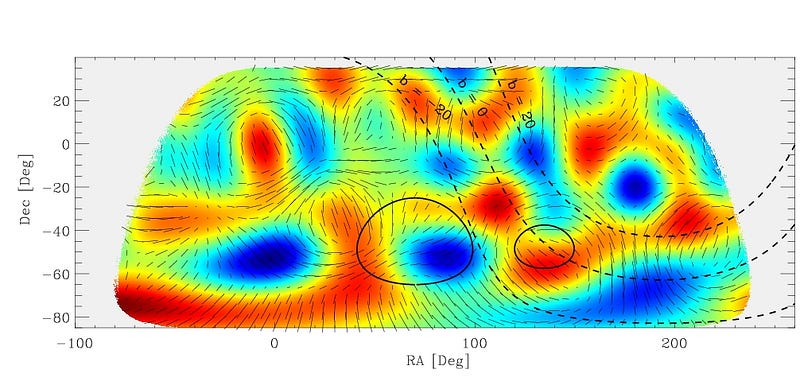
The polarization in the cosmic microwave background tells us — confirms for us — that neutrinos do exist and do affect the Universe, but can make up only about 0.1% of the energy content of the Universe. That’s not nothing, but it’s not the dark matter we need. What is it? Stay tuned; we’re still working on it!
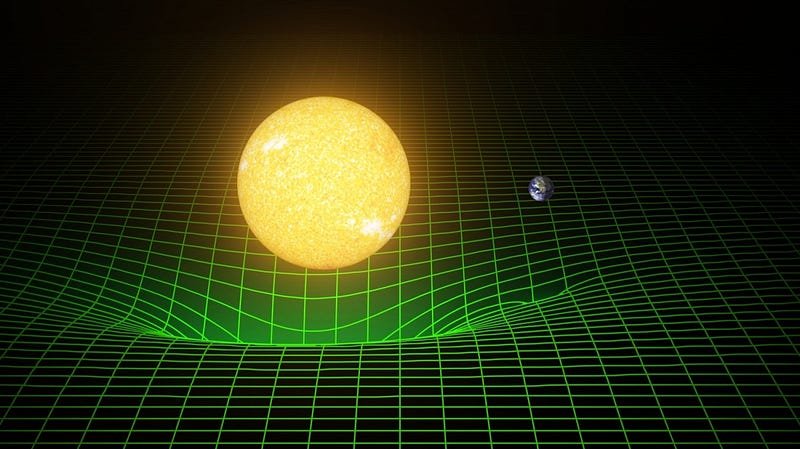
3:55 PM: Yes, you’re going to want to know: gravitational waves and dark matter/dark energy? Dark matter should emit them as it moves through the Universe, changing gravitational fields, but because it’s so diffuse, the magnitude of these waves should be tiny. Yet that’s better than dark energy, which may not emit gravitational waves at all!
3:58 PM: So if it isn’t normal matter — nothing in the standard model — whatis dark matter? There are lots of good candidates: high-energy relics that are left over from the early Universe, like from supersymmetry or extra dimensions; axions, which arise from the broken symmetry that (theoretically) explains why there’s no CP-violation in the strong interactions; heavy, see-sawed right-handed neutrinos; ultra-heavy relics arising in grand unified theories, etc. But dark energy candidates? We don’t even know how to begin looking for those!

4:00 PM: Okay, enough of my commentary, it looks like it’s time to begin!
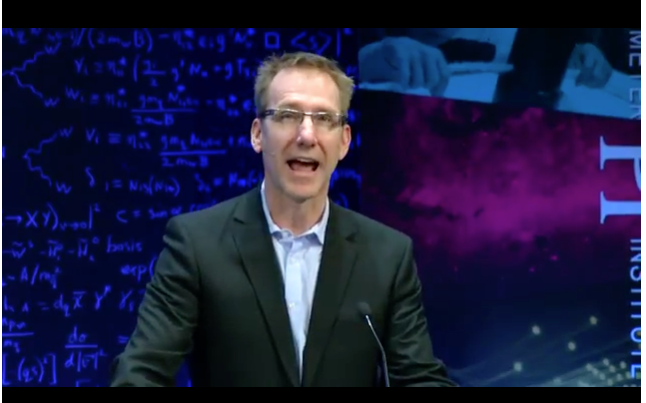
4:02 PM: Incredible introduction, and more incredible: a scientist — a Ph.D. scientist — a Ph.D. woman scientist, has a high-ranking government position where science holds a prominent, influential role in governing her nation. Do we not need more of this across the world?
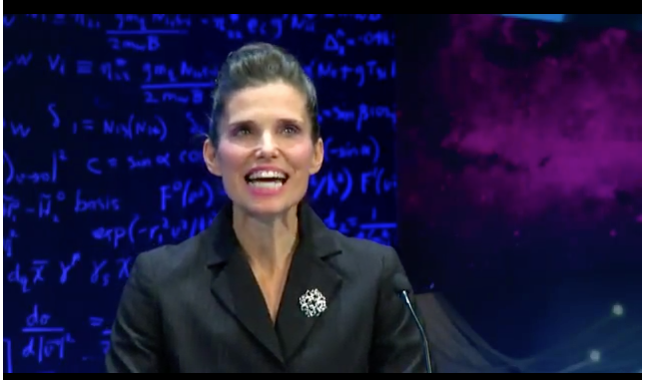
4:05 PM: “It is worth noting that Dr. Freese is one of the first women to earn an undergraduate physics degree from Princeton, and last year Business Insider named her one of the most amazing 15 women in science today.” It’s wonderful that finally we can have a list of “amazing women in science” without the word “hot” in there. Let us hope that someday soon, we can have a list of way more that 15, and that won’t even be notable.
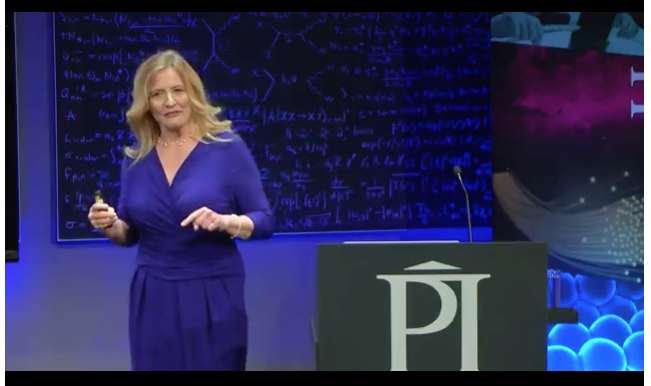
4:07 PM: Every culture has their own creation myth, and yet in the last 100 years — and it really is only in the last 100 years — that we’ve moved this from a myth or a story to actual scientific knowledge. From Einstein’s relativity to Slipher’s and Hubble’s observations that led to an expanding Universe, we answered the ultimate question: where our Universe came from in the past!
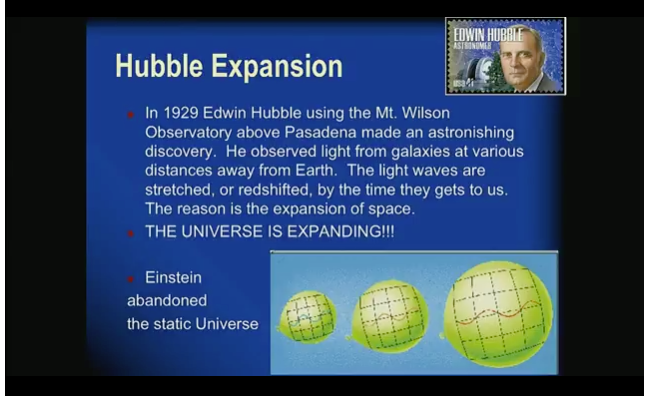
4:10 PM: As emitted light stretches as the Universe expands, we can tell how much our Universe has expanded (and at what rate) by looking farther and farther back in time. It’s really that simple: light takes time to travel to you through space, space expands and that stretches the light that “rides” through it, and so if you observe galaxies at all different distances, you can tell how it’s expanded over time. We’ve looked back a looooong ways!
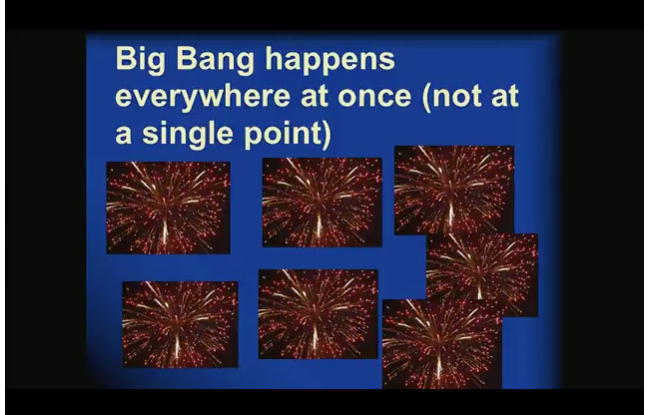
4:14 PM: A nice way of addressing a common misconception about the Big Bang: it’s not an explosion that happened somewhere with us at the center. Instead, it’s an event in our past that occurred everywhere at once, like an explosion (if you must) where the energy in empty space “exploded” into matter and radiation uniformly, and everywhere at once!
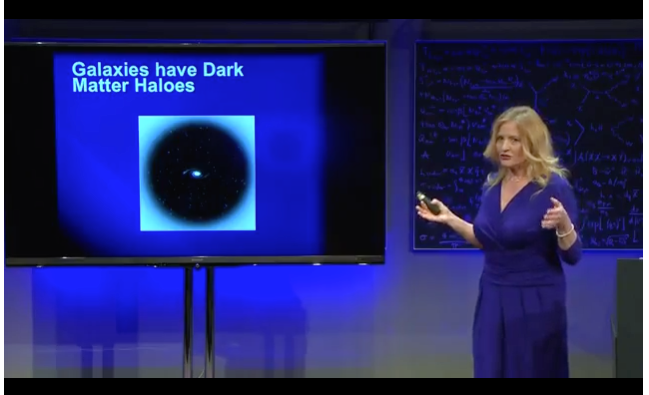
4:17 PM: We think of our galaxy as the disk, bulge and arms, where the stars live and where the gas-and-dust form. But that’s an inaccurate view of our galaxy if we care about mass. By mass — inferring this from how things move — there’s a giant, diffuse halo many times the scale of the visible disk.

4:19 PM: If you’re watching this live, you may notice that questions are being asked on Twitter in real-time with the hashtag #piLIVE. I hope they answer this one, because the best I have is:
- Do what you love.
- Anyone who discourages you can go to hell.
- Surround yourself with people as committed to your success (as you define it) as you are.
- And be the best version of yourself that you can.
You can do it, and I hope you do.
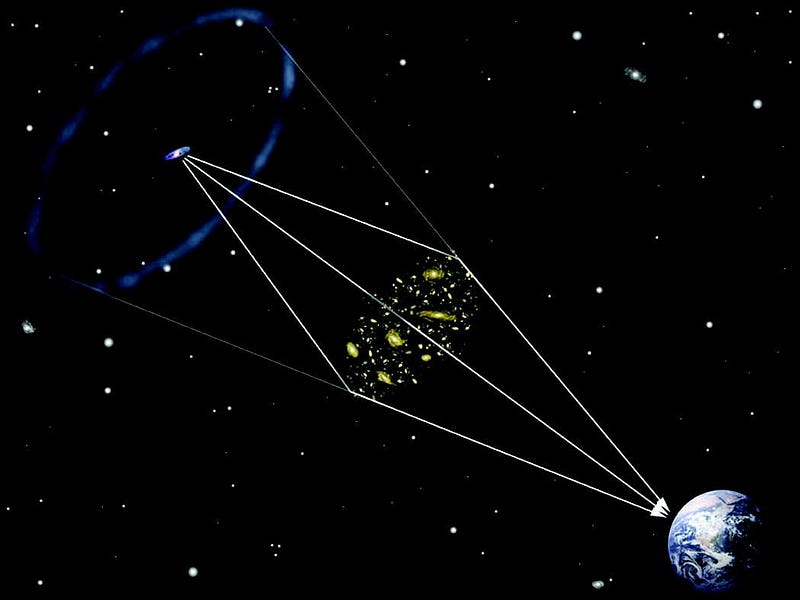
4:24 PM: When you image the distant Universe, you can — via the effects of bent background light — measure the total amount of mass in between youand the object you’re observing. This effect is known as gravitational lensing, and it tells us that there’s not only mass (matter) where the galaxies are, but in between the galaxies, where there are no stars. That’s another piece of evidence for dark matter.
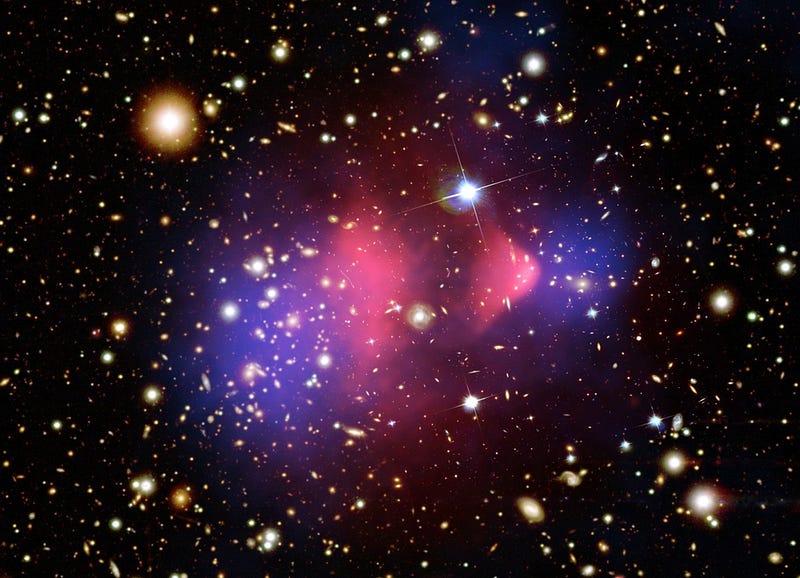
Lensing Map: NASA/STScI; ESO WFI; Magellan/U.Arizona/ D.Clowe et al.
Optical: NASA/STScI; Magellan/U.Arizona/D.Clowe et al.
4:27 PM: The strongest, most direct evidence for dark matter comes from the collisions of clusters. Not only is the gravitational effect (shown in blue) misaligned from the normal matter (shown in pink), but its magnitude is some 5–6 times greater than the normal matter would lead us to believe. In other words, we have many different lines of evidence on many different scales that dark matter is real, and that it vastly outmasses normal matter, like us.
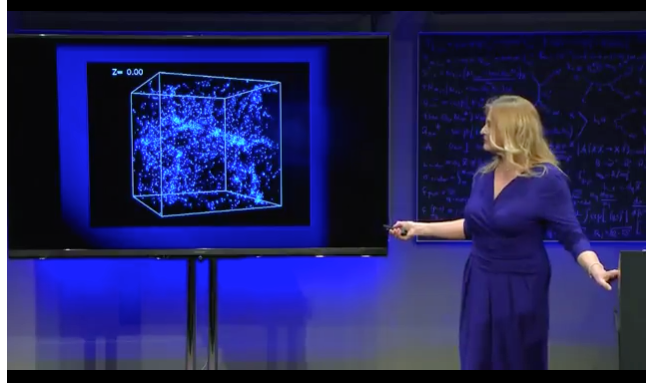
4:30 PM: One more, because it’s too good: we need dark matter for us to exist! Form stars, have lots of radiation, make supernovae, etc., and what do they do? They push against normal matter, and would actually destroy structure on both large and small scales, which our Universe has plenty of! So you need dark matter to hold that together, because it doesn’t care about the radiation, which passes right through it. Imagine that: without dark matter, our galaxies — and the heavy elements that arise from supernova remnants to make us — wouldn’t remain bound together the way they do!
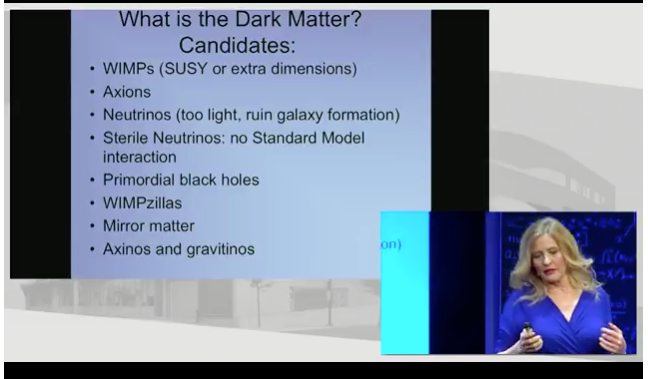
4:34 PM: Awww, bummer! Katie puts up a (partial) list of potential dark matter candidates, and is going to focus on WIMPs. Yes, the consensus is that WIMPs are a good candidate for dark matter, but this has kind of been talked (and modeled) to death in recent years, with not even a hint of evidence to show for it. The motivations she’s giving are related to SUSY and extra dimensions, which pretty definitively don’t exist at the scales we’d need them to exist to solve the dark matter problem. (Or the LHC would have already found them.)
You heard it here first: if the LHC, during its current run, doesn’t see any new particles below ~1 TeV in energy, WIMPs as we currently motivate them cannot be 100% of the dark matter.
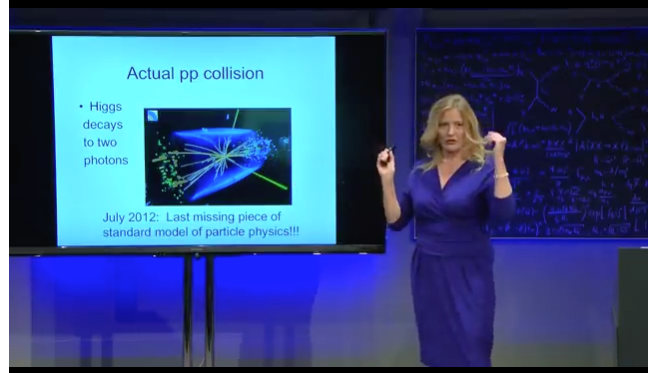
4:38 PM: I don’t think Katie would dispute that statement, either; she’s saying right now that finding the Higgs boson was one goal of the LHC, but the other main goal was to find something new that could be evidence of one of these WIMP-producing theories, like SUSY or Kaluza-Klein particles. Tl;dr version: so far that hasn’t happened, we hope it’s coming, and the “hints” of new physics are about as convincing as the argument that I am actually godzilla, typing this live blog, right now.
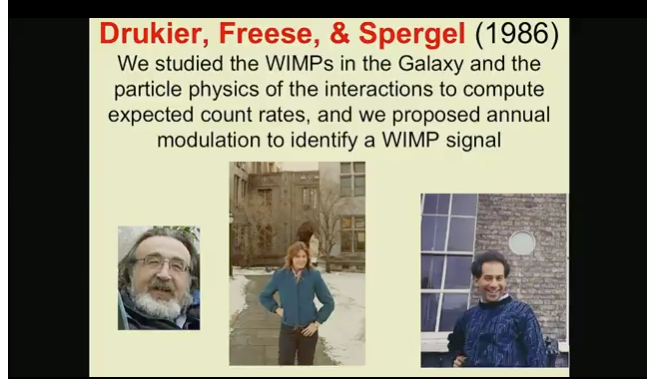
4:42 PM: FYI, if you’re looking for neutrinos, you can build a giant underground detector looking for interactions — although rare — between normal matter and neutrinos. If, and this is a big if, the “W” in WIMP (Weakly Interacting Massive Particle) actually stands for “weak force” and not just “weaker than we can see,” there’s a chance that we can detect it. But the experiments conflict with each other, and there’s no clear positive signal. Yes, DAMA detects an annual modulation in their signal, but they don’t understand the nature of their signal at all. They’re seeing something, but is it dark matter? Noise? Orbital/heating mechanics? No one knows.
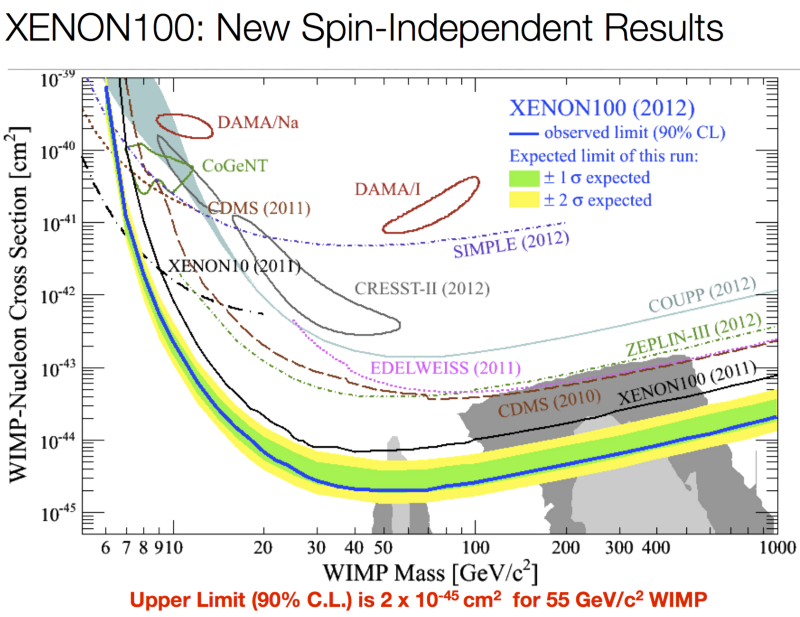
4:45 PM: Here are some science results showing the DAMA detector’s “claimed detection” and all the other experiments, that rule out WIMPs at all locations above the lines they’re drawn on. If you have money and you’re a betting person, do not bet on DAMA. That’s my advice. I won’t call them this myself, but I will relay that there are a number of people who have started calling the DAMA believers a very funny portmanteau of “DAMA” and one of Beavis & Butthead’s favorite words. You can figure out the rest.
4:48 PM: I do love how Katie is such an optimist, given the incredible string of non-detection and non-confirmation of all claimed “direct detection” efforts on dark matter so far. I do have to say (and admit) that all it takes is one confirmed, reproducible result, and we’ll have our first window as to the nature of dark matter.
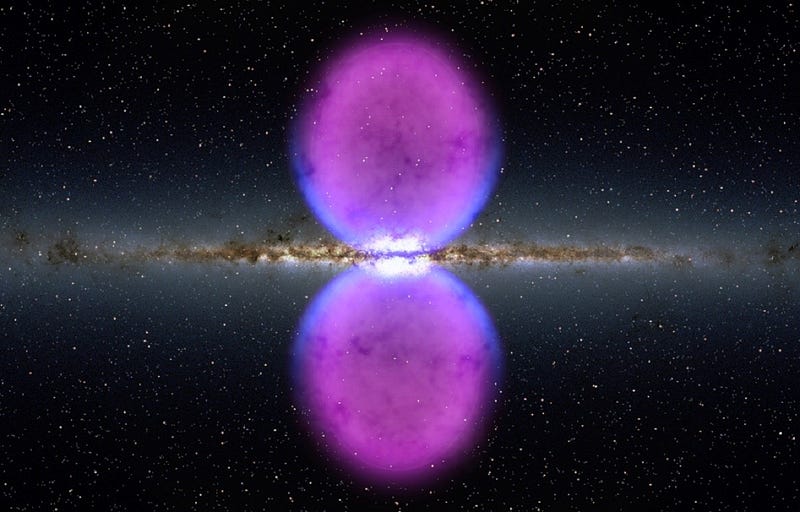
But with all that said, everything she’s talking about — the Fermi bubbles, etc. — have mundane explanations, where mundane means “astrophysical, based on known physics,” with no need for dark matter.
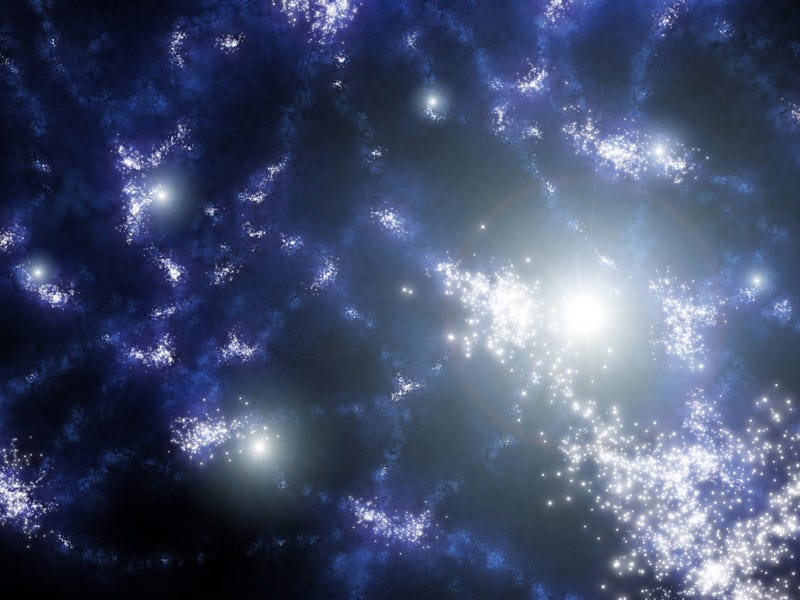
4:52 PM: There’s also “dark stars,” which is Katie’s (and a few others’) pet idea, that the first stars would not only be rich (relatively) in dark matter, and huge (up to ~1,000,000 solar masses, rather than the standard ~1,000 solar masses), but that dark matter self-annihilates, and that self-annihilation powers these stars in a particular fashion. If she’s right (a lot of ifs), at least the James Webb Space Telescope has a chance to see it! She’s probably not right, but a big part of being a theorist is about considering the possibilities and the consequences that arise from those possibilities, not about calculating onlywhat we already expect!
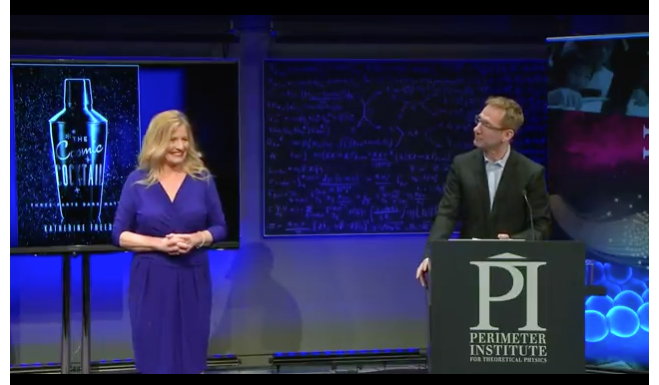
4:56 PM: Katie is of the same mindset as I am when it comes to dark energy: it’s a very hard problem that we do not even begin to know how to investigate directly. At least with dark matter, we have options and possibilities, and avenues to explore. But for dark energy… all we can do is watch for its effects on the expansion of the Universe. Anything else? Perhaps that’s for the next generation of theorists!
5:00 PM: Good question: will dark matter lead to grand unification? The answer is possibly, if an important component of dark matter actually comes from either the symmetry breaking or the symmetry restoration of the electroweak-strong force. This doesn’t require supersymmetry, as Katie says, but it does require grand unification to be a real part of our Universe, which it may or may not be.
5:02 PM: And finally, the women-who-want-to-be-scientists question: “If you love it, keep doing it,” and don’t let insecure male students who act like they know everything (and don’t) get you down.
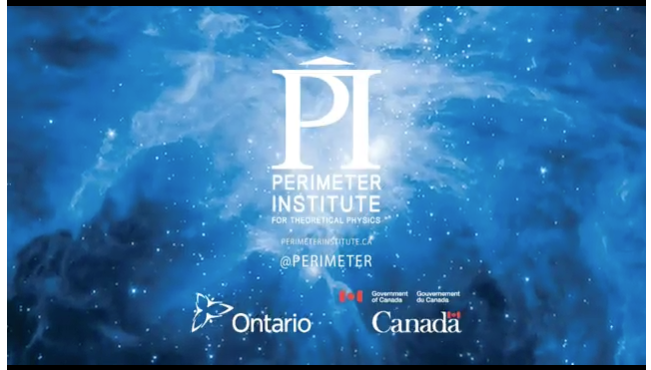
Thanks to Perimeter Institute for helping me participate, for Katie Freese for giving such a wonderful talk, and for everyone who watched — either here or elsewhere — for tuning in. Bringing the story of the Universe, including the frontiers of the Universe, to everyone, is a big part of what the enterprise of science is all about!
This post first appeared at Forbes. Leave your comments on our forum, check out our first book: Beyond The Galaxy, and support our Patreon campaign!




